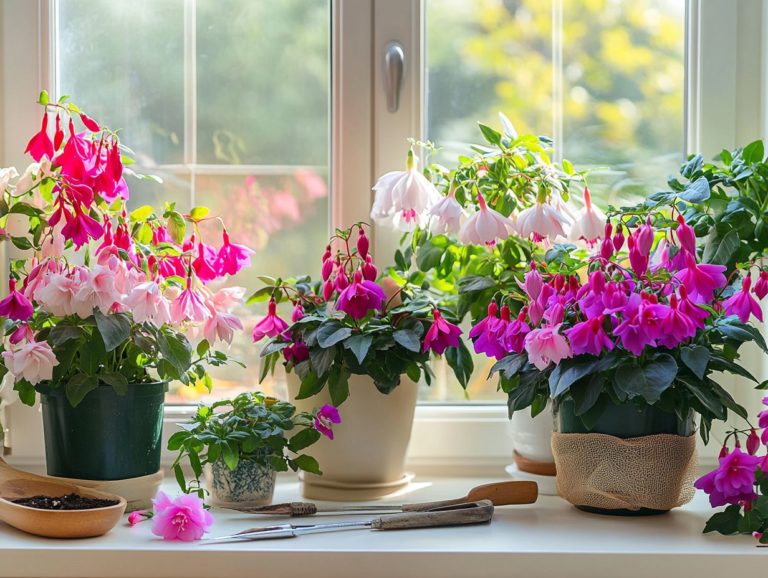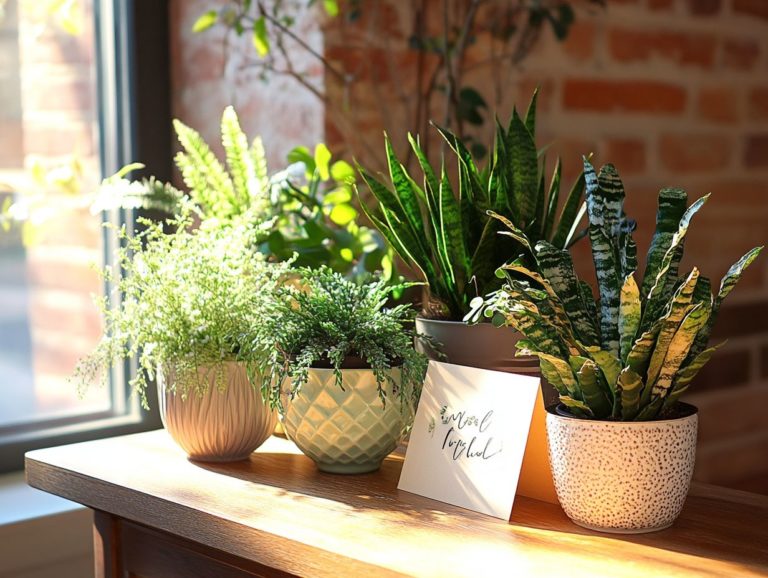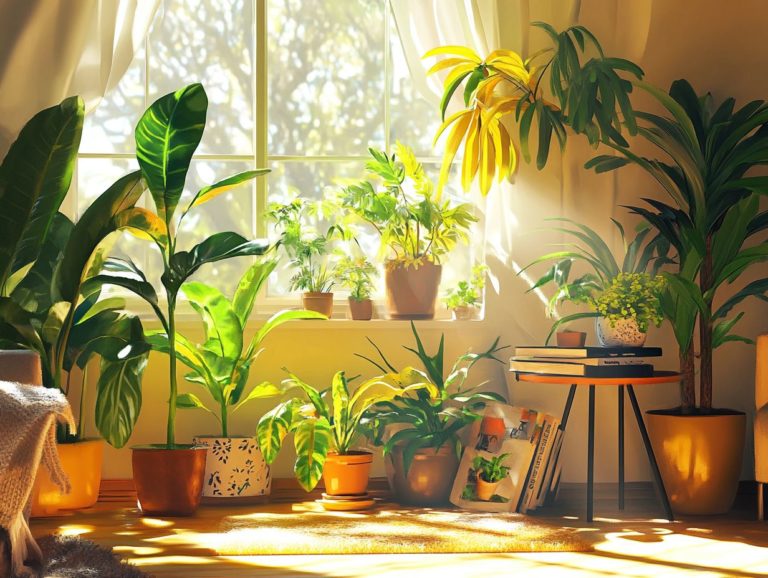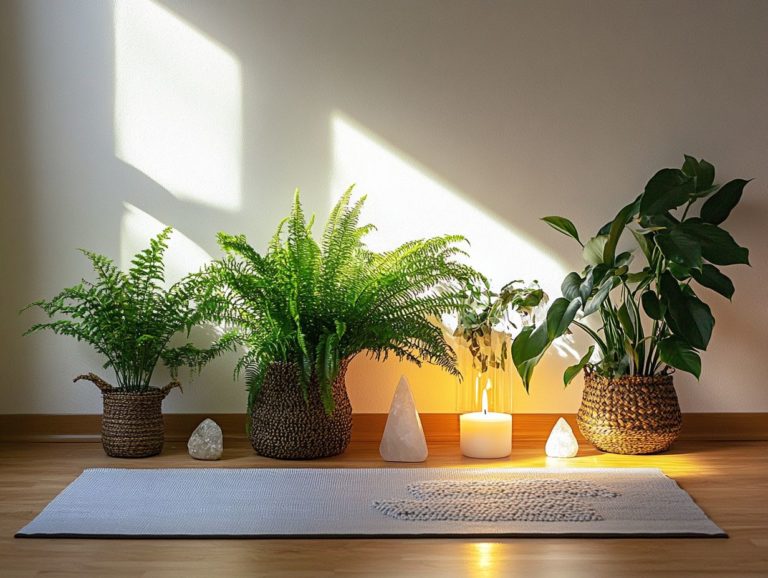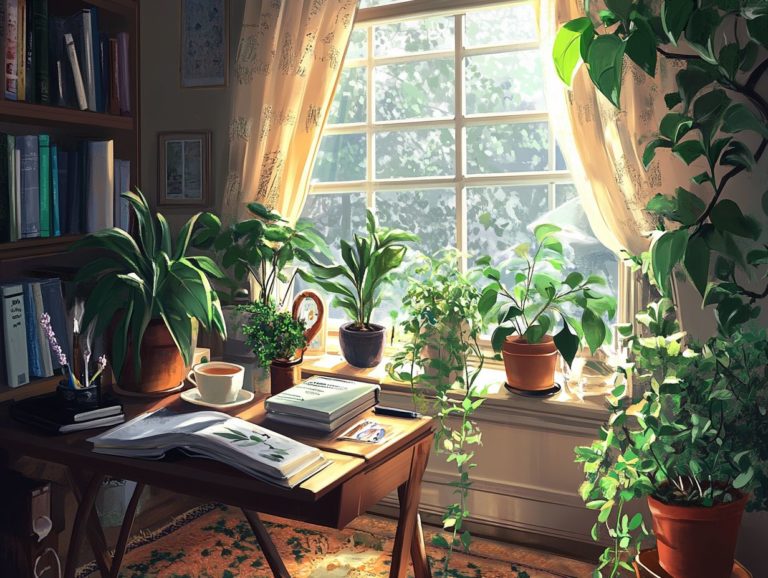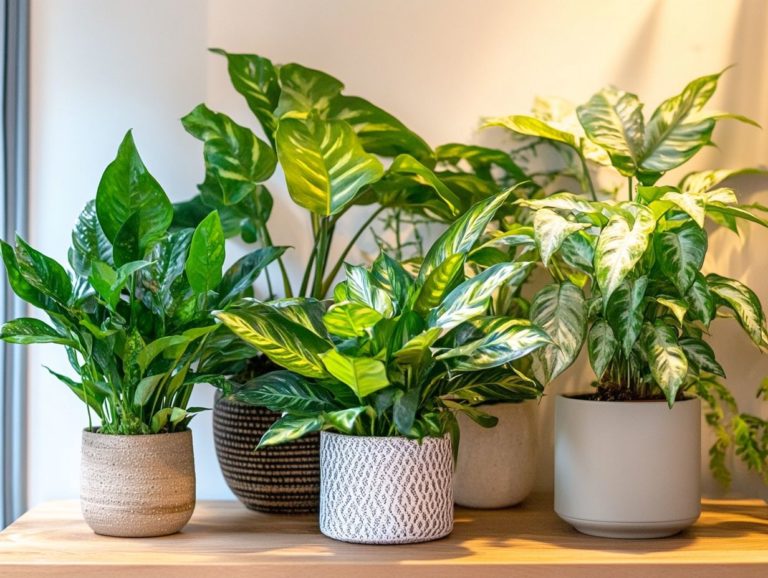Peace Lily Varieties: A Care Overview
Peace lilies are more than just houseplants. They bring life and calm to any space.
With their captivating white blooms and vibrant green leaves, these plants appeal to both novices and experienced green thumbs alike.
This article covers many types of peace lilies. It explains how to care for them and offers solutions for common problems. It also explores propagation techniques and creative ways to display these exquisite plants in your home, ensuring you can enjoy their beauty while keeping them thriving.
Contents
Key Takeaways:

- Peace lilies are popular houseplants known for their beautiful white flowers and ability to filter the air, making them excellent indoor plants.
- There are various types of peace lilies, including the classic *Spathiphyllum wallisii* and the variegated *Spathiphyllum sensation*.
- To care for peace lilies, provide them with bright, indirect light, keep the soil consistently moist, and use well-draining potting mix.
Overview of the Plant and its Characteristics
The Peace Lily, scientifically known as *Spathiphyllum*, is a captivating tropical houseplant that deserves a spot in your indoor oasis. Celebrated for its striking white flowers and lush green leaves, this beauty hails from the vibrant regions of South America, particularly Colombia and Venezuela.
Not only does it add elegance to your space, but it also acts as a diligent air purifier, filtering out unwanted pollutants.
With its easy maintenance and adaptability to various conditions, the Peace Lily is the perfect companion for both novice and seasoned plant lovers.
One of its standout features is the way it blooms: elegant white spathes that can grace your home for months, typically from spring through fall, with just a bit of care.
Among the different varieties, options like Domino and Mauna Loa showcase unique foliage patterns and sizes, catering to your personal style.
To keep your Peace Lily flourishing, offer it a home in indirect sunlight, provide consistent watering, and treat it to occasional fertilization. This amazing plant not only enhances your indoor air quality but also contributes to a serene atmosphere, making it an ideal choice for both home and office environments.
Popular Peace Lily Varieties
In the world of Peace Lilies, a few standout varieties capture attention, each boasting unique qualities that elevate their status as desirable indoor plants. The classic Peace Lily takes a prominent place, complemented by the robust African mask plant and the visually striking Zebra Plant.
Other species like Monstera adansonii add to the diversity of beautiful peace lily options. Each of these species belongs to the Araceae family, showcasing distinct variations in leaf shape and growth patterns that contribute to their individual charm.
These variations highlight the adaptability of peace lilies in indoor environments.
Different Types of Peace Lilies
Different types of Peace Lilies, like the Spathiphyllum Mauna Loa and Spathiphyllum Picasso, each bring their own unique charm and character to your interior spaces.
The Spathiphyllum Mauna Loa, with its impressive, glossy leaves and striking white flowers, is a superstar in low-light conditions. This makes it perfect for those dimly lit corners of your home. Its forgiving nature means you won t need a green thumb; just keep the soil moist without turning it into a swamp.
On the flip side, the Spathiphyllum Picasso dazzles with its variegated leaves that add a splash of visual intrigue, ideal for brightening up a contemporary setting. This variety enjoys a bit more light but still thrives in moderate conditions, and it appreciates regular misting to keep its vibrant foliage looking its best.
Both of these stunning options effortlessly elevate your indoor d cor, infusing your space with a sense of elegance and tranquility.
How to Care for Peace Lilies
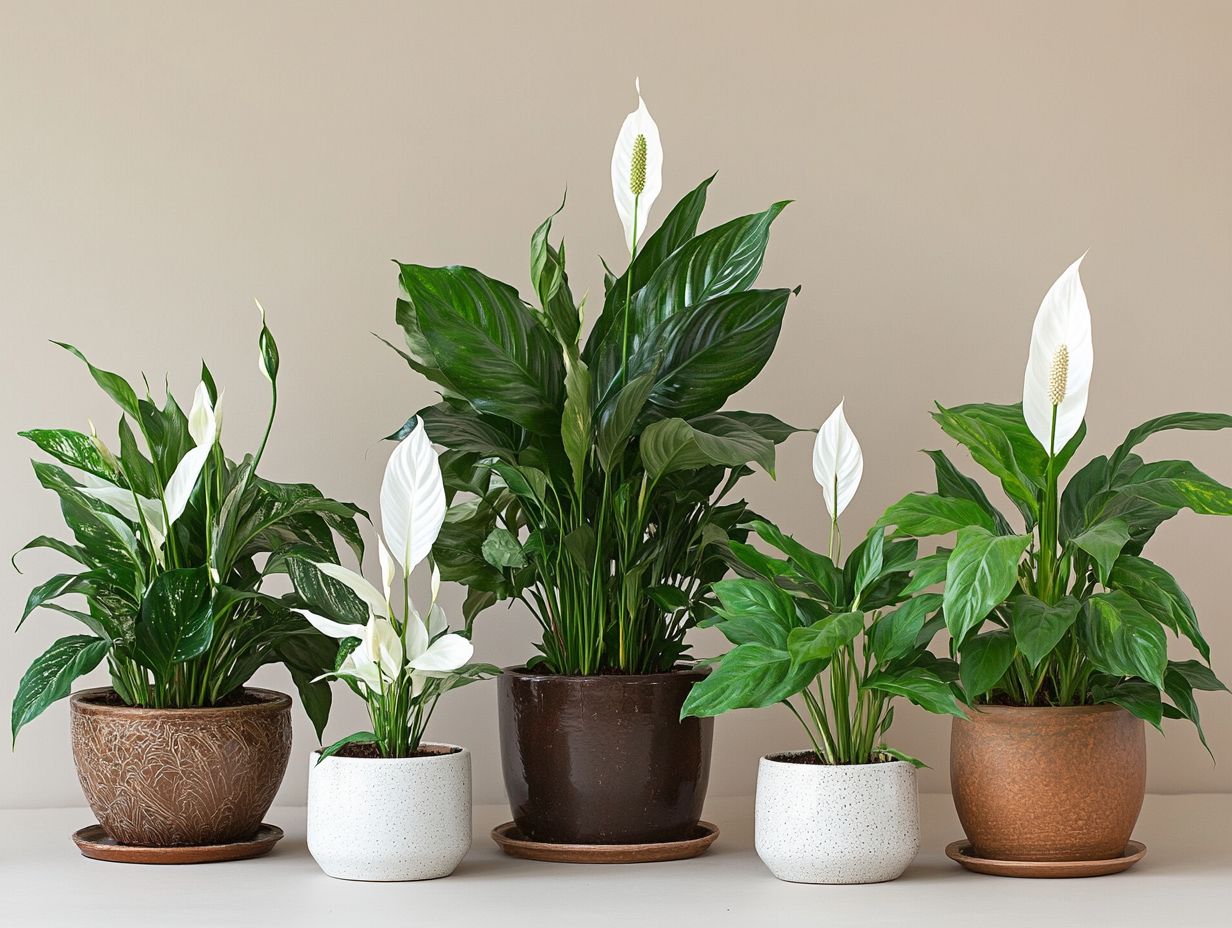
Caring for Peace Lilies demands a delicate balance of light, water, and humidity to achieve optimal growth and health. Get ready to create a vibrant indoor garden with your Peace Lilies!
These elegant houseplants flourish in indirect light conditions and prefer their soil to be evenly moist, making careful watering to avoid root rot crucial. Root rot is a condition where roots decay due to excess water.
Keeping a consistent temperature and humidity level encourages lush foliage and stunning blooms, beautifully echoing the plant’s tropical heritage.
Light, Water, and Soil Requirements
The light, water, and soil requirements for Peace Lilies are essential for achieving their healthy growth and stunning blooms.
To truly thrive, these plants prefer bright, indirect light that replicates their natural habitat beneath the lush canopies of tropical forests. Exposing them to direct sunlight can scorch their leaves, resulting in those not-so-attractive brown tips.
Maintaining the right light conditions is key to their overall health.
Regarding watering, aim to keep the soil consistently moist but never soggy. Allowing the top inch of soil to dry out between waterings is crucial to prevent root rot and ensure healthy growth.
Use a potting mix that drains well and has organic material. A blend of peat moss, perlite, and pine bark creates the perfect environment for robust root development and lush, vibrant foliage. This mix also aids in retaining the right moisture level for optimal plant health.
Common Issues and Troubleshooting
Despite their resilience, Peace Lilies can face a few common challenges that might impede their growth and overall well-being. Recognizing and addressing issues like pest infestations, disease outbreaks, and environmental factors is crucial for nurturing a flourishing indoor plant.
Understanding these potential problems helps you troubleshoot confidently, ensuring your Peace Lily continues to be an exquisite focal point in any room.
Tips for Dealing with Pests and Diseases
To keep your Peace Lily thriving, you must remain attentive to common pests and diseases that threaten its growth.
Among the most notorious offenders are spider mites and aphids, both of which can swiftly damage those lush leaves you adore. Spotting signs of infestation like fine webbing or sticky residue is essential for taking prompt action.
Diseases such as root rot can quietly undermine your plant s health, usually caused by overwatering and inadequate drainage. To prevent these issues, ensure that the soil is moist but never saturated. Consider using neem oil as an effective, natural pesticide to safeguard your Peace Lily.
By regularly inspecting your plant, you’ll significantly impact its vitality and overall well-being.
Propagation and Repotting
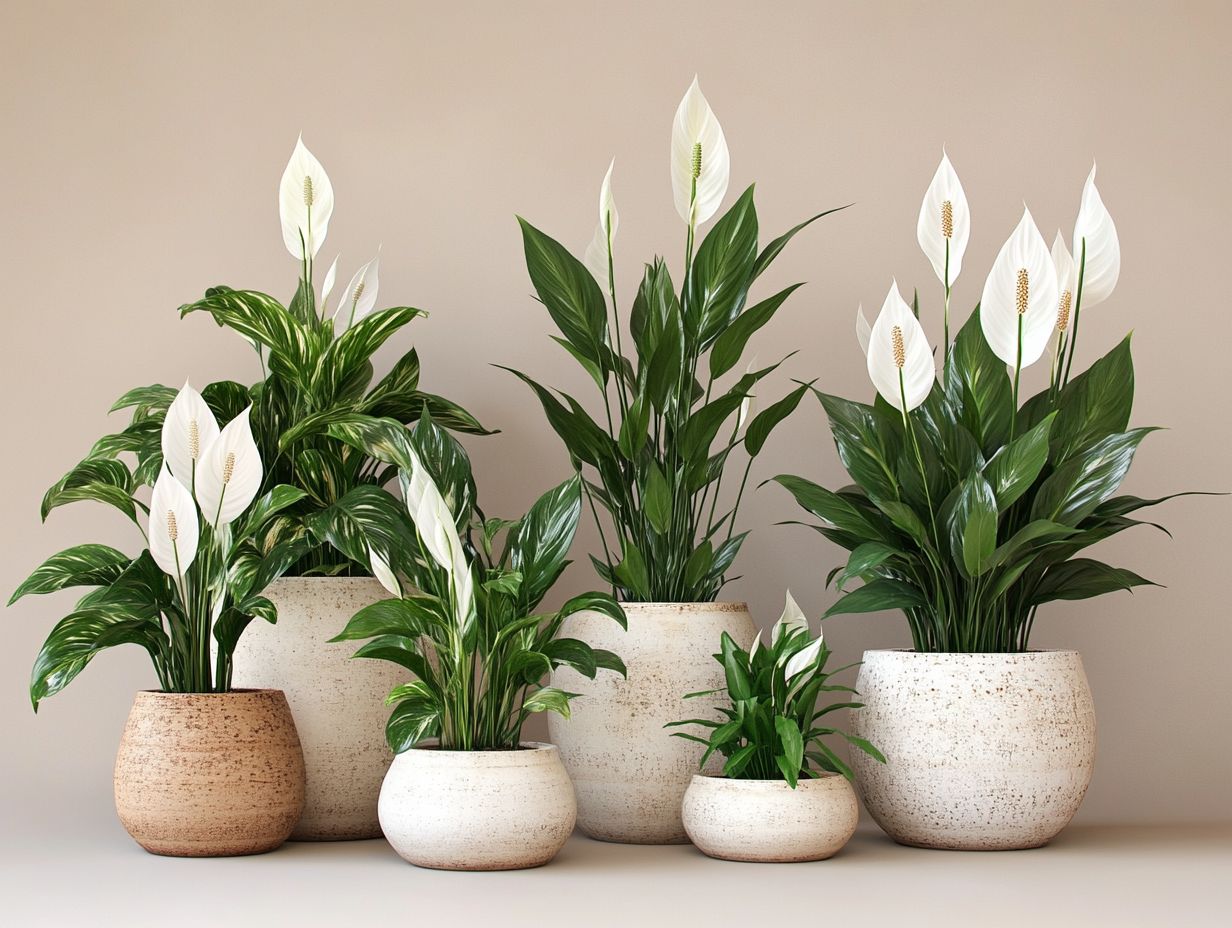
Propagation and repotting are vital techniques for nurturing a thriving Peace Lily. By grasping the right timing and methods, you can ensure that your plant flourishes beautifully.
This involves careful division at the roots and supplying fresh potting soil that will support its new growth, setting the stage for a lush and healthy plant.
Start exploring these techniques today and watch your Peace Lily thrive!
Methods for Growing New Plants and Repotting Peace Lilies
There are several effective methods for growing new plants and repotting Peace Lilies that can help you maintain their vigor and health. This ensures that your indoor plants remain beautiful.
One of the most popular techniques is division: splitting the plant into parts, where you carefully separate the plant into smaller sections, each with its own roots. This allows you to cultivate thriving new plants.
Another option is to utilize offsets those charming little new plants that sprout from the base. They can be detached easily, contributing to a vibrant indoor space.
When it comes to repotting, using well-draining soil is essential. This type of soil caters to their moisture needs while promoting healthy root development.
And don t forget about drainage! Ensuring your pot has adequate holes will prevent the dreaded overwatering issues and support your plant’s overall care and longevity.
Decorative Uses for Peace Lilies
Did you know Peace Lilies can transform your space? These plants are exquisite houseplants that elevate the aesthetic charm of any indoor area. With their striking white blooms and vibrant green foliage, they adapt seamlessly to a variety of design styles, whether modern or traditional.
Their presence adds beauty and enhances the overall indoor environment. They not only enhance your decor but also purify the air! This creates a more inviting and healthier environment.
Creative Ways to Display and Use Peace Lilies in Your Home
Creative displays of Peace Lilies can truly transform your indoor spaces, showcasing their exquisite beauty and elevating your home decor. Whether displayed alone or grouped with other plants, these stunning houseplants are a key element in any interior design.
Choose decorative pots that fit your style! The lush green leaves will make a bold statement. Incorporating elegant plant stands not only brings these enchanting houseplants to eye level but also adds layers and depth to your environment, contributing to a beautiful indoor atmosphere.
Grouping them with other houseplants creates a vibrant mini-garden atmosphere, infusing your arrangement with energy. Whether nestled in a cozy corner or positioned as a centerpiece on your dining table, these thoughtful displays can effortlessly elevate the overall aesthetic of your home. They can turn ordinary areas into inviting, lively retreats that highlight the beauty of your indoor plants.
Frequently Asked Questions
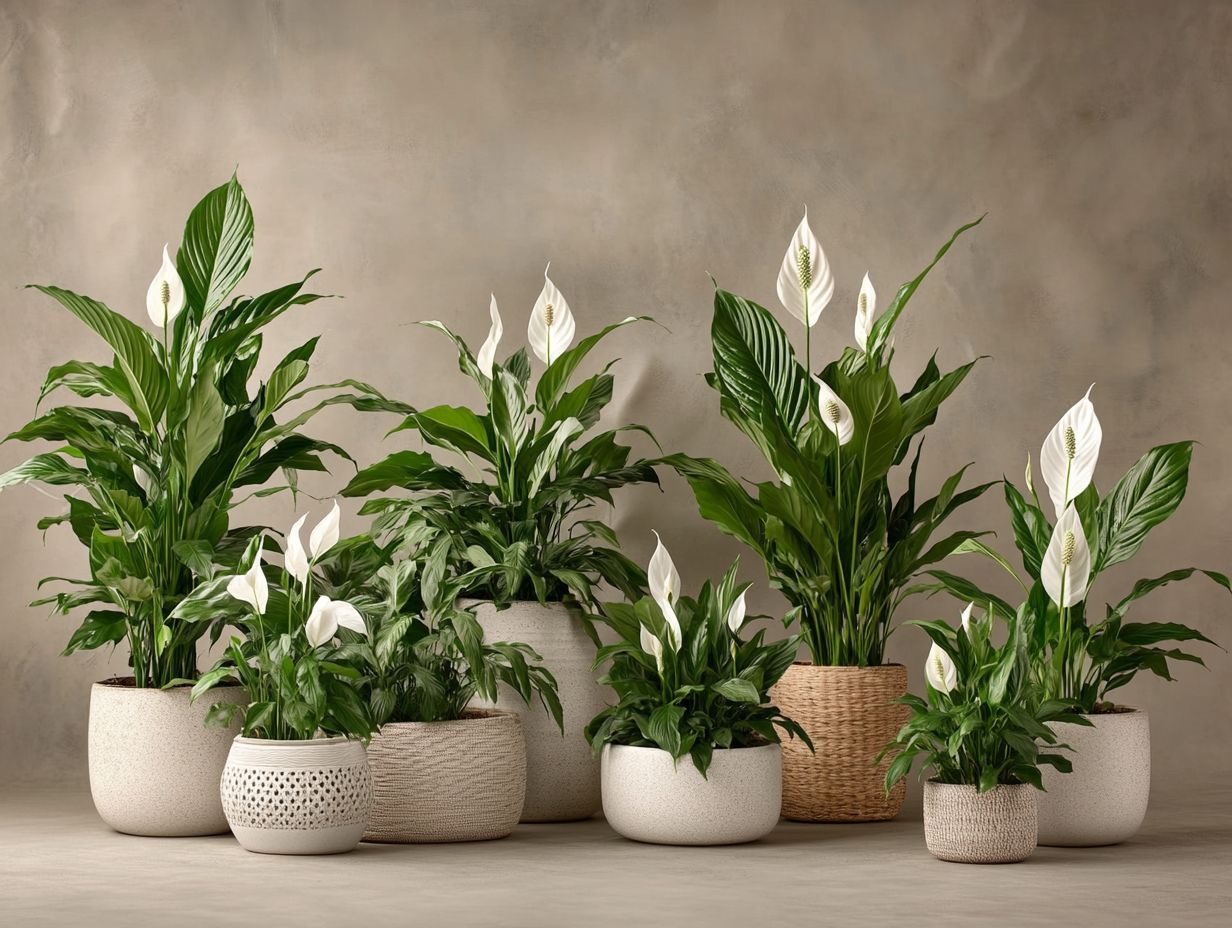
There are several Peace Lily varieties, including the classic Spathiphyllum wallisii, the compact Petite Peace Lily, the larger Sensation Peace Lily, and the variegated Domino Peace Lily.
2. Do all Peace Lily varieties have the same care requirements, considering their origins in South America?
While all Peace Lily varieties belong to the same plant family, each variety may have slightly different care needs. It’s important to research the specific variety you have to ensure proper care. For those interested in similar plants, understanding snake plants: care and varieties can provide valuable insights.
3. How often should I water my Peace Lily, especially during Winter and Spring?
Peace Lilies like to have consistently moist soil, but not soggy. Depending on the size of your pot and the temperature of your home, you may need to water every 1-2 weeks.
4. Can I keep my Peace Lily in a dark corner of my home, or does it need more shade?
No, Peace Lilies require bright, indirect light to thrive. Placing them in a dark corner may cause them to droop and not produce flowers.
5. How can I encourage my Peace Lily to bloom, especially during Spring?
To encourage blooming, make sure your plant is getting enough light, and fertilize every 2-3 months during the growing season. You can also try placing it in a slightly cooler room (around 65-75 F).
6. Are Peace Lilies safe to have around children and pets, given their properties?
While Peace Lilies are generally considered safe, all parts of the plant contain calcium oxalate crystals that can cause irritation if ingested. It’s best to keep them out of reach of children and pets.

